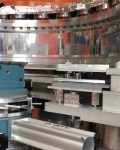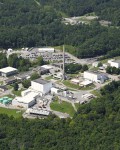At low temperature and pressure, water crystallizes in two distinct morphologies, termed ice Ih and ice XI. In ordinary ice Ih, the oxygen atoms for a hexagonal lattice, with the two hydrogen atoms distributed randomly at the corners of a rough tetrahedron enclosing each oxygen atom. In ice XI, the hydrogen atoms become ordered and the resulting solid is ferroelectric. In ferroelectric ice the chemical bonds are aligned in the same direction so that a net polarization in one direction produces an electric field. The stability of ice XI is of particular interest because of its possible formation in space and its implications in the formation of planets.
The transformation of ice Ih to ice XI is dominated by the process of H diffusion in normal ice and is very slow so it cannot be observed in laboratory-time scales. To accelerate the H diffusion process researchers dope water samples with potassium hydroxide (or other dopants). These impurities promote the mobility of H atoms and accelerate the nucleation process.
In 2006, Fukazawa et al. [Astrophysics J 652, L57 (2006)] reported the successful production of large quantities of Ice XI in an experiment at the Wide-Angle Neutron Diffractometer (WAND) at HFIR by doping D2O (deuterated to raise the neutron scattering efficiency) with very small amounts of KOD, and then carefully maintaining the samples between 57 and 66 K over tens of hours.
These neutron diffraction experiments showed that the existence of ice XI in cold space environments is likely in the narrow temperature range of 57-66 K (which corresponds to the temperatures of Uranus and its satellites).
In a paper published in Geophysical Research Letters (see full citation below) a group of scientist from the University of Tokyo, the Japan Atomic Energy Agency, and ORNL reported that the existence of ferroelectric ice XI is more prevalent than originally thought. Small domains of hydrogen-ordered ice can exist in normal ice at temperatures significantly higher than observed before.
This neutron powder diffraction study, which was also performed at WAND, found that small hydrogen-ordered domains exist up to 111 K in ice that has previously been transformed to the ordered form and the domains nucleate the growth of bulk ice XI. Since this memory exists up to at least 111 K, this study shows that most ices in the solar system are hydrogen ordered and could exhibit ferroelectricity. The strong electrostatic force between ice XI grains makes them attract and increases the probability of aggregation of icy grains in wider region of space. This study suggests that the small hydrogen-ordered domains govern the cosmochemical evolution of icy grains in the universe.
This work was performed under the auspices of the US-Japan Cooperative Program on Neutron Scattering. The work at the HFIR was sponsored by the Division of Scientific User Facilities, Office of Basic Energy Sciences, US Department of Energy.
Published Work
Masashi Arakawa, Hiroyuki Kagi, Jaime A. Fernandez-Baca, Bryan C. Chakoumakos, and Hiroshi Fukazawa, "The existence of memory effect on hydrogen ordering in ice: The effect makes ice attractive," Geo. Res. Lett. 38, L16101 (2011) doi:10.1029/2011GL048217.




